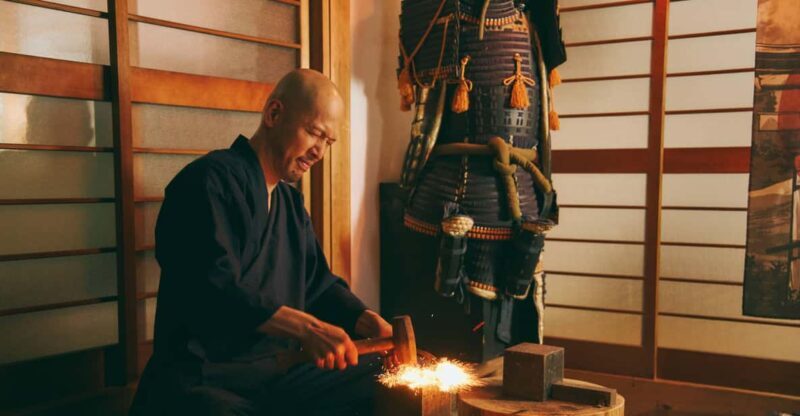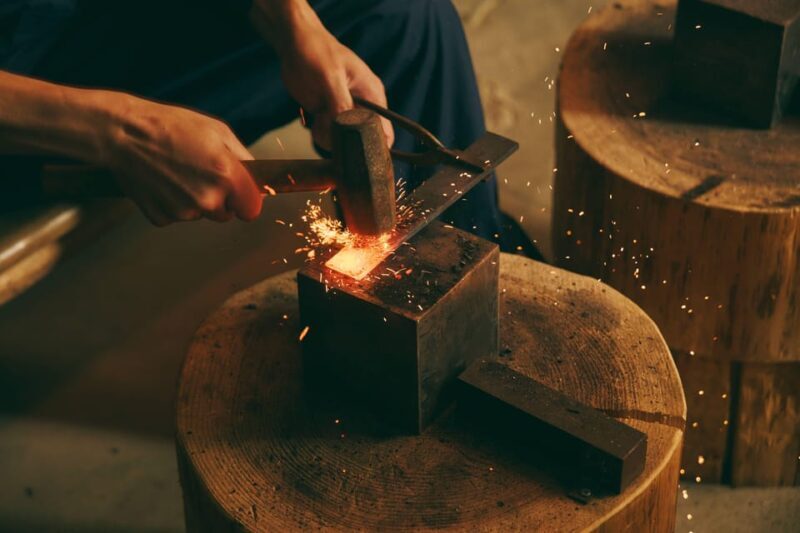Authentic Knife Making Experience at a Blacksmith in Kyoto

If you’ve ever wanted to touch a piece of Japan’s craft heritage, this knife-making experience in Kyoto offers an authentic, hands-on journey into traditional blacksmithing. Located at Studio NIN in the quiet, storied neighborhood of Sakyo-ku, this 3-hour class costs around $161 per person, making it a surprisingly good value for such a personalized craft session. Led by Mao, an experienced blacksmith with over ten years sharpening knives, this class takes you through the full process of forging a Japanese kitchen knife, ending with a usable, handmade tool you can take home.
Two aspects we truly appreciate are the chance to wear traditional costumes, which makes the experience feel immersive and authentic, and the opportunity to see and handle the entire blacksmithing process, from heating the iron to polishing the finished product. The intimate group size—limited to just six participants—ensures plenty of personalized guidance.
One thing to consider is that forging involves physical effort, with a good deal of hammering and kneeling. It’s not a casual souvenir making session; it’s a true craft experience that requires some endurance. But if you’re curious about Japanese craftsmanship or enjoy working with your hands, this is a memorable highlight.
This experience suits travelers looking for something unique and culturally rich, especially those interested in traditional crafts, cooking, or handmade souvenirs. It’s perfect for individuals or small groups who want to learn a skill, create something practical, and gain insight into Japan’s legendary knife-making heritage.
You can check availability for your dates here:Key Points

- Authentic craftsmanship: You’ll forge a traditional Japanese kitchen knife using real blacksmithing techniques.
- Authentic attire: Dressing in traditional costumes adds to the culture.
- Expert guidance: Mao, a seasoned professional, will guide you step-by-step, making it accessible even for beginners.
- Practical end product: You get to take home a usable, approximately 13-15 cm knife—perfect for gifting or personal use.
- Limited group size: Small groups (up to 6) enhance the learning experience and personal attention.
- Value for money: The experience offers a meaningful connection to Japanese culture at a reasonable price, especially considering it includes all materials, tools, and your finished knife.
Planning more time in Kyoto? We've covered other experiences worth considering.
The Experience in Detail

Location and Meeting Point
The class begins at Studio NIN, an unassuming but traditional building in Kyoto’s Sakyo-ku neighborhood. The studio can be recognized by its large gate and a flag bearing the Shuriken logo. While the street in front is narrow, taxis can pass easily, which is helpful if you’re arriving from elsewhere in Kyoto. The studio’s atmosphere hints at Japan’s craftsmanship roots—simple, functional, and welcoming.
What You Can Expect
The experience is carefully designed to balance learning and hands-on forging. Your day starts with dressing up in a traditional goldsmith outfit, setting the tone for an immersive cultural experience. Mao, your instructor, will explain the history and significance of Japanese knife-making—though the focus remains on the process.
You’ll learn how to use various tools: from heating the steel to shaping it with a hammer, and finally polishing the blade. Mao’s teaching style is approachable, especially helpful for beginners, and his explanations make the process understandable. The forging phase is the core of the experience, involving repeated strikes of a hammer on hot iron. This part is physically demanding but rewarding, and Mao will demonstrate proper technique and safety protocols.
More Great Tours NearbyThe Crafting Process
The process begins with heating the steel until it’s malleable. Then, you’ll take turns striking the iron with a hammer, gradually shaping the knife. Some reviews highlight the “crazy workout” involved—hammering in a hot room while standing or kneeling. The entire process emphasizes tradition and craftsmanship, making each knife unique.
After forging, Mao will show you how to sharpen and polish the blade, ensuring it’s functional and safe. Because the knife is handmade, its size ranges from about 13 to 15 centimeters, and the shape may vary slightly based on individual skill and effort.
- 2-Hour Shopping Tour Plan / private
- 6-Day Private Tour to Kyoto via Fukui from Fukuoka with Bus
- 2 Types of Japanese Sweets making and Tea Ceremony
- Kyoto: Insider Sake Brewery Tour with Sake and Food Pairing
- 4.5-hr Kyoto Historical Highlights Bike Tour with UNESCO
- 4-Day Scenic Japan Tour by Car: Tokyo Mt. Fuji Kyoto & Osaka
Unique Features
Unlike many knife-making classes, this experience does not involve wooden handles—your finished knife has a simple, iron handle. This reflects the traditional method and keeps the process straightforward. For those wanting a more elaborate or larger knife, note that more time and money are involved—such as a longer, more detailed session that could take over five hours and cost over $400.
What’s Included and What To Bring
All tools, materials, costumes, and safety gear are provided. You’ll also receive a box and bag to carry your finished knife home, along with a towel and water for after the work. The only thing to prepare is wearing socks—a small but important detail, especially in a traditional setting.
What Previous Participants Say

Reviews are overwhelmingly positive, with a 4.9 out of 5 rating based on 67 comments. Many praise the knowledgeable guides and the authenticity of the experience. Ashley describes it as an “excellent experience” that’s also a “crazy workout”, emphasizing its physicality and fun. Laura found the process “quite satisfying,” appreciating how the instructors guided her throughout.
Many reviewers highlight how much they learned. Kasi mentions, “I learned so much and am happy with my knife and handle”—a sentiment shared by others who appreciated the personalized guidance. Simi called it “super worth it,” while Joseph Austin explained that it was “one of the most important opportunities” during his trip, emphasizing the cultural connection and craftsmanship.
Several reviews also mention the stunning atmosphere of the studio and the joy of creating something tangible. Luca, a metalworker himself, appreciated that it was not too basic and felt it was a genuine craft. Kekoa called it “amazing,” and Tao described it as “super rewarding.”
A common thread is the sense of achievement—leaving with a practical, handcrafted knife that serves as both a useful tool and a memorable souvenir. Many also enjoyed the small group size, which makes the experience feel intimate and accessible.
Practical Considerations
Participants mention that the forging process is physically demanding. You should be prepared for some sweat and effort, especially during the hammering stage. The room can be surprisingly cold despite the fires, so wearing heavier socks is advisable. Because safety is important, the activity involves dangerous work, but Mao and his team provide thorough guidance to minimize risks.
Children under 15 are not allowed unless accompanied by an adult, and the experience isn’t suitable for those over 95. It’s also important to remember no alcohol or drugs are permitted, given the safety risks involved.
Why Choose This Experience?
This class offers more than just making a knife; it’s about understanding the art of Japanese blacksmithing. If you enjoy hands-on activities, are curious about traditional crafts, or want a meaningful souvenir, you’ll find this experience rewarding. It’s also perfect if you’re seeking a cultural highlight that’s different from typical sightseeing.
For those who love learning new skills or simply want to try something unforgettable, this is a unique chance to connect with Japan’s artisan spirit. The fact that you get to take home a knife you made yourself makes it a practical and memorable keepsake.
The Sum Up

The Kyoto blacksmith knife-making class is a genuine, engaging way to connect with Japan’s craftsmanship. It combines culture with practical skill-building in a small, friendly setting. You’ll leave with a usable knife and a much deeper appreciation for the artistry involved in Japanese cutlery.
This experience is especially well-suited for adventurous travelers, craft enthusiasts, or anyone eager to make a lasting memory of Kyoto. If you’re looking for a meaningful, hands-on activity that goes beyond typical tours, this is a perfect choice. It’s an authentic, fun, and surprisingly demanding journey into the world of blacksmithing that offers both education and entertainment.
FAQ
Is this experience suitable for children?
Children under 15 must be accompanied by a parent or guardian. It’s a physically demanding activity, so it may not be ideal for very young kids.
How long does the class last?
It runs for about 3 hours, giving enough time for instruction, forging, sharpening, and polishing. Check availability for specific start times.
What should I wear?
Wear comfortable clothes and socks—they’re required. Expect to be in a workshop environment, so dress appropriately for some physical work and possible heat.
Can I take photographs during the class?
Yes. Video and photography are encouraged, so you can capture your process and finished product.
Is the knife handle made of wood?
No, the handles are made of iron, reflecting a traditional and simple method. Larger or more elaborate knives would involve more time and cost.
What if I want a bigger or more detailed knife?
A more elaborate or larger knife takes longer (over 5 hours) and costs more (over $400). This class focuses on a practical 13-15 cm knife made straightforwardly.
Is the process dangerous?
The activity involves dangerous work, primarily forging with a hammer. Mao and staff provide safety instructions and supervision, but participants should be aware of the physical intensity and risks involved.
This kiln-baked craft offers a rare chance to create something tangible and truly Japanese. Whether you’re a craft lover, a culinary enthusiast, or simply curious, this is a memorable way to spend part of your time in Kyoto—learning, shaping, and taking home a piece of Japan’s iron art.
You can check availability for your dates here:More Tour Reviews in Kyoto
- From Osaka: Kyoto Highlights One Day Private Tour
- From Osaka/Kyoto: Private Kyoto and Nara Day Trip
- From Osaka: Sagano Train Ride and Kyoto Guided Day Tour
- From Osaka/Kyoto: Kyoto, Nara, and Fushimi Inari Day Trip
- From Osaka/Kyoto: Kyoto UNESCO World Heritage Sites Day Tour
- From Osaka/Kyoto: Private Kyoto & Nara Day Trip with Pickup
More Kyoto experiences we've covered
- From Osaka: Kyoto Highlights One Day Private Tour
- From Osaka/Kyoto: Private Kyoto and Nara Day Trip
- From Osaka/Kyoto: Amanohashidate Day Tour with Lunch
- From Osaka/Kyoto: Amanohashidate Day TourIncluding tickets
- From Osaka: Sagano Train Ride and Kyoto Guided Day Tour
- From Osaka/Kyoto: Kyoto, Nara, and Fushimi Inari Day Trip
- From Osaka/Kyoto: Nara One Day Private Tour
- From Osaka/Kyoto: Kyoto UNESCO World Heritage Sites Day Tour
- From Osaka/Kyoto: Shirakawa-go and Gokayama Day Tour
- From Osaka: Kyoto Private Day Tour
- From Osaka: Kyoto and Nara Day Tour with Deer Sightings
- From Osaka/Kyoto: Private Kyoto & Nara Day Trip with Pickup
